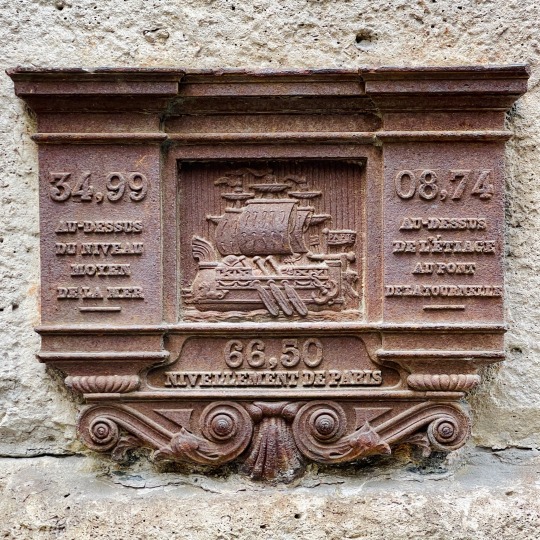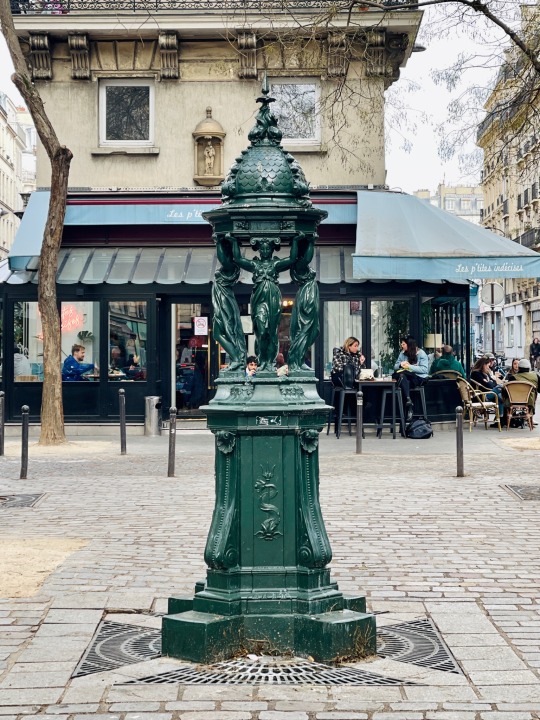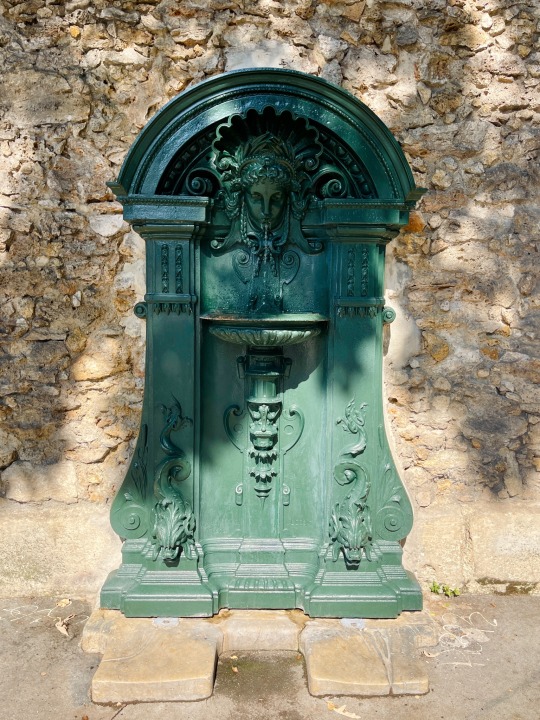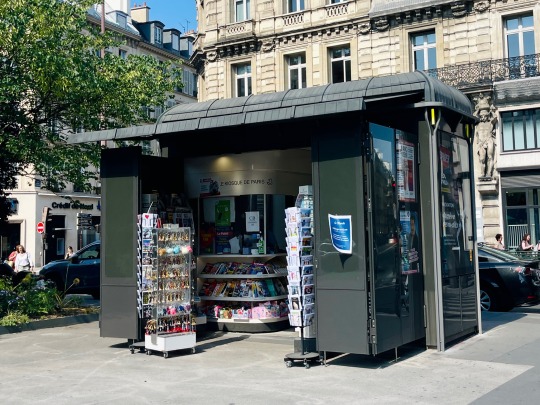#CelineThrowBackThursdayInParis
Explore tagged Tumblr posts
Text


.
Trivia Tuesday… Last pavements made of wood
In Paris, there are still remnants of the old wooden paving stones installed in the 19th century in the English fashion.
Rectangular in shape, they were quieter and less traumatic for horses' hooves. Why did they disappear? Because, over the years, they decompose, giving off nauseating odors. In 1910, during the great flood, the wooden cobblestones lifted. They were abandoned in the 1930s. During the war, they served another purpose, as firewood during the harsh winters. (Source: Les Franciliens)
#celineisnotanexpatanymore#france life#paris#CelineThrowBackThursdayInParis#CelineFunFactsInParis#CelineTriviaInParis
3 notes
·
View notes
Text

.
Thursday Throw Back… Rails with no train
Walking around the arcades on place des Vosges, away from the side with many art galleries and not far from the oldest graffiti, one will notice rails at the entrance to the porte cochère of the Hôtel de Rotrou. According to the Office de tourisme de Paris, "this building was simply the headquarters of the Compagnie internationale des wagons-lits, and this door gave access to the kitchens, which supplied the stations". Dishes were loaded onto the rails and then onto trucks in the square, before being transported all over Paris in these refrigerated trucks. Sandwiches and snacks for Paris stations and the Grands Hôtels des Wagons-lits were prepared and packaged at Place des Vosges until 1954.
The company was founded in 1872 by Belgian businessman Georges Nagelmackers. Inspired by the model of the night trains launched in the United States by Colonel Pullman's company, with whom he formed an early partnership, he built Europe's first sleeping and dining cars, and in 1883 launched the Grand Express d'Orient between Paris and Constantinople, which became the famous Orient-Express, and the Rome-Express between Calais and Rome, via Paris.
3 notes
·
View notes
Text


.
Thursday Throwback… to your former life.
For a moment you thought you walked too far and ended up in Beijing.
4 notes
·
View notes
Text

.
Throwback Thursday… way way back. One of the oldest street in Paris
Rue Francois Miron is one of the oldest streets of Paris. It replaces a section of the Roman road that linked Lutetia, antic Paris, to the city of Melun in the east. This small enclave of the Quartier St-Gervais escaped demolition during Haussmann‘s renovation of Paris in the mid 19th century.
The half-timbered Maison du Faucheur at no11 and Maison du Mouton at no13 were named after ancient shops signs, most likely inns. They were built in the 14th century, but were raised during the 16th century. Therefore, only their ground-floors qualify them to be listed among the oldest houses in Paris.
In accordance with the former building regulation enforced in Paris their timber-framed facades were originally covered with plaster in order to limit fire hazard. This rendering was removed during restoration work conducted in 1967 when André Malraux, the Minister of Culture, made the Marais a Protected Area.
10 notes
·
View notes
Text


.
Thursday Throwback…way way back. Nivellement de Paris (leveling plans).
This console landmark is probably the best preserved in the capital at Rue des Grands-Augustins in the 6th arrondissement.
The first edict concerning the leveling of Paris dates from 1607. In 1811, in order to distribute the waters of the Ourcq and to know all the points where it could be conveyed by gravity, the municipal administration expressed the wish that leveling plans be attached to existing alignment plans. Leveling plates appear from 1856. These altimetric markers plates, in cast iron surmounted by a console and adorned with the arms of the city for the oldest, made it possible to know the leveling and to calculate the slopes necessary for the flow of water.
* 34.99 m = The average sea level measured at Fort Saint-Jean in Marseille. = level of the low point (26.25 m) + height above this level (8.74 m);
* 8.74 m = The altitude above the low water level at the Tournelle bridge. This is the lowest water level of the Seine in 1719, This elevation will be used to establish the route of the future sewers which must, by gravity, flow into the Seine.
* 66.50 m = the leveling of Paris represents the difference between the elevation of the high water level of La Villette (51.49 m), increased by 50 meters (= 5 bars of pressure?) and the altitude in relation to the average sea level (34.99 m). That is 51.49+50-34.99m. This rating will be used to design the distribution by gravity of the water coming from this same basin (they will then be downgraded to non-potable water). (Source)
4 notes
·
View notes
Text

.
Thursday Throw Back… way way back - The Oldest…Bakery in Paris.
This pastry shop “Patisserie Stohrer” in the center of Paris bears the name of its founder Nicolas Stohrer, pastry chef to King Louis XV. Founded in 1730, it is considered the oldest pastry shop in the capital, people come here to taste appetizing sweet and savory creations, but also to admire its sumptuous decor, listed as a historical monument.
The interior of the shop is designed by Paul Baudry a French painter who lived in Paris during the 19th-century. Other famous places decorated by the artist include Opera Garnier and Musée d’Orsay.
Nicolas Stohrer, Franco-Polish pastry chef, is the inventor of rum baba. A dessert whose name derived from the Polish word baba – grandmother in the language of children.
6 notes
·
View notes
Text

.
Thursday Throwback… Wallace Fountain
Wallace fountains are named after their donor, Sir Richard Wallace (1818-1890). Inspired by London's "drinking fountains", they were originally fitted with pewter cups held in place by a chain, which were removed for hygiene reasons in 1952. The first Wallace fountain was installed in 1872 on Boulevard de la Villette.
Born in London Richard Wallace spent most of his life in Bagatelle (Parisian suburbs). Heir to a large fortune, this philanthropist donated 50 drinking fountains to the city after seeing Parisians suffer water shortages during the siege of Paris and the Commune in 1871. Such was the response that he financed a further 10 fountains in 1876, and a further 10 three years later. In this respect, the Wallace fountains were the first major public/private cooperative effort to meet an essential human need: providing access to drinking water for all. Designed as true works of art, the Wallace fountains are adorned with four caryatids, each representing an allegory: Simplicity, Kindness, Sobriety and Charity. Today, 107 of them can be admired in the streets of the capital. The fountains are still in operation today, providing drinking water for tourists and Parisians alike. (They operate from March 15 to November 15, in order to minimize the risk of freezing temperatures during the winter months and jeopardizing internal plumbing)
Sculptor Charles-Auguste Lebourg used cast iron, a hard-wearing material that was easy to produce. The fountain parts, representing 600 kilos of cast iron, were cast in three pieces (base, central part and cap). Today, the original mold is still used to create new models. The choice of color goes back to Napoleon III and his desire to introduce nature into the city. The color was imposed by the City of Paris to ensure the coherence of the urban landscape, like the newsstands and the colonne Morris. (Source
There’s only one Surface-mounted fountain left (rue Geoffroy-Saint-Hilaire, near the Jardin des Plantes)

5 notes
·
View notes
Text

.
Thursday Throwback… Advertising columns known as Morris columns.
In the mid-19th century, Paris and Berlin faced the same problem; with the emergence of new entertainment venues, advertisements were popping up all over the streets, on walls, trees and railings, but above all on public urinals, which doubled as toilets and billboards.
In 1845, in Berlin, German printer and inventor Ernst Litfaß found a solution to this problem by erecting furniture specially dedicated to advertising and prohibiting uncontrolled billposting. The first Litfaß columns, or Litfaßsäule, were inaugurated in 1855. A few years later in Paris, it was the printer Gabriel Morris, who specialized in advertising Parisian shows, who took the initiative of setting up places entirely dedicated to advertising posters. The Prefect of Police had a dozen of these models installed on the Grands Boulevards, which were at the time overloaded with advertisements for shows at nearby theaters. The City of Paris gave Morris the advertising monopoly on the columns, which became known in popular parlance as "Morris columns". Between 1868 and the mid-1870s, 451 columns, each able to accommodate 4m² of advertising dedicated to Parisian cultural offerings, were put into service. Built in cast iron and painted in the green color so characteristic of Parisian furniture, Morris columns quickly became emblematic elements of the Parisian landscape. So much so, in fact, that they are featured in numerous paintings by painters of the Belle Époque, as well as in the neoclassical and eclectic architecture of the 19th century. (Source)
3 notes
·
View notes
Text

.
Thursday Throwback... Kiosque a Journaux (Newsstands)
We owed the newsstands to Baron Haussmann (who was also in charge of transforming the old medieval Paris into what we know today as the "Haussmannian" buildings built along the wide avenues opening up Paris). French architect Gabriel Davioud was commissioned to design small, elegant pavilions. It was on the Grands Boulevards that the first kiosk was built (on August 15, 1857), responding to the desire to gentrify one of Paris's greatest boulevard. In a minor revolution, the new kiosks, equipped with a lighting system, now lit up the public boulevards at night! But just two years later, these pretty, innovative designs were replaced by others deemed even more beautiful. By 1859, the new Parisian kiosks were even more imposing: taller, they were surrounded by friezes and topped by domes of zinc scales and a spire. By the end of the 19th century, the style and practicality of these kiosks, with their awning and display, gradually increased to 340 by the 1880s.
Today, there are around 360 newsagents in Paris, slightly more than in 1880. But it hasn't always been easy. In 2004, for example, there were just 266 newsagents left in the capital, as newsagents went bankrupt or abandoned a business deemed too difficult and unprofitable. To stem this loss, Paris City Council decided to give newsagents a break on the licence fee they had been paying up until then, before authorizing them to diversify their products at the end of 2011, with a single requirement for newsagents: that the press represent at least 2/3 of their business.

News-stands have almost all changed their appearance since 2018, as Paris City Hall launched a major operation to replace the classic model with brand-new, sleeker and more modern ones, a shelter made of recyclable metal, aluminum and glass, whose glass façade lets in natural light and is inspired by artists' studios and Parisian rooftops. (Source)
NB: The last 4 remaining Kiosk Type 1900 (all converted to Flower shops) can be found: place d'Estienne d'Orves (9th), 21 avenue du général Sarrail (16th), 30 avenue Corentin Cariou (19th) and 6 boulevard de Charonne (20th)
#CelineIsNotAnExpatAnymore#France life#Paris#kiosque a journaux#newsstand#CelineThrowbackThursdayInParis
4 notes
·
View notes
Text

.
Thursday Throwback… One of the last Pèse Personne.
Public weighing scale. These used to be placed in prominent position in front of pharmacies, in parks and metro platforms long before people would have personal weighing scales at home. The weighing had become a Sunday ritual. It would be hard to imagine people doing it nowadays. Not that I have ever shy from being weighed in public ;-)
I found this one in Jardin du Luxembourg where apparently there are 2 more.
2 notes
·
View notes
Text



.
Thursday Throwback… One of the last Manège à Bras
Installed in 1913, a stone's throw from the Eiffel Tower, this merry-go-round turns with a crank activated by human energy with its original wooden horses (authentic horses sculpted by the famous Limonaire brothers), as well as the game of rings of yesteryear.
Inspired by medieval jousts, where horsemen competed for the favors of these ladies, this attraction is a vestige of a bygone era. The Manège1913 has survived the years and generations of toddlers, retaining its original manual mechanism, despite the electrical advances. Indeed, its operation is similar to the drawing of water by a system of simple crank and cogs.
All the charm of this carousel lies in its manual mechanism, operated by the person in charge in the center of the carousel, with the strength of the arms. In addition, this system also makes it possible to generate electricity, making it a pure ecological work of art, fully in line with our times, and sustainable development. (Source)
2 notes
·
View notes
Text


.
Thursday Throwback… Last Avertisseur d’Incendie in Paris.
I must have walked by it a few dozen times and never noticed it... maybe because I arrive from the north side of the street and the Fire Alarm is in the reinforcement of a wall.
In 1884, the first public fire hydrant was built. It allowed, in case of emergency, to contact the nearest fire station by breaking the glass of a small door located at the top of the hydrant.
The last one still present in Paris and was placed in front of the entrance of the Sévigné fire station as a duty of memory. It was made in 1947 by the Association of workers in precision instruments, in collaboration with the technical services of the Paris fire department. The generalization of private telephones in the 1970's has made the call boxes obsolete.
2 notes
·
View notes
Text



.
Throwback Thursday... One of the last Sand boxes in Paris.
If I didn't read about them from my research for the series "the oldest...in Paris" I wouldn't have noticed them.
The sand boxes were placed on the Parisian pavements at the end of the 19th century as winter sanding was used when the streets were icy or covered with snow. It was also the waste from horses pulling carts, cabs and omnibuses that made the streets particularly slippery so sand was used to soak up the horses’ urine before being swept away.
To make it easier to road menders, the municipality of Paris placed approximately 30 sand boxes across the city. The workers drew sand from a little hatch at the base of the box.
The last 5 sandboxes can be found on avenue de Saxe (7th), avenue de Friedland (8th), avenue Gabriel (8th), place de la Reine-Astrid (8th) and avenue Trudaine (9th)
2 notes
·
View notes
Text

.
Thursday Throw Back… way way back - The Oldest… Cafe in Paris.
Le Procope opened in 1686
Established in 1686 by an Italian chef named Francesco Procopio dei Coltelli, Le Procope or Café Procope is considered the oldest café in Paris – it is also widely called the oldest continuously operating restaurant in the city. Many people also believe that Le Procope was the first ever European coffeehouse and that it birthed coffeehouse culture as we know it. Coltelli served Italian sorbets as well as the newly discovered coffee and Le Procope a hot spot for artists, intellectuals, actors, and other distinguished people after the Ancienne Comédie Française theatre opened nearby.
In its early days, many great French writers such as Jean-Jacques Rousseau, Voltaire, and Denis Diderot often spent time at Le Procope. Voltaire’s loved Le Procope so much that his favorite table has been preserved and now serves as a shrine to the author. Le Procope became so prolific that famous thinkers and writers from around the world also stopped by, including Thomas Jefferson and Benjamin Franklin. In the late 1980s, Le Procope was renovated to mimic 18th century designs and now serves a full menu.
4 notes
·
View notes
Text

.
Thursday Throwback… The last Vespasienne
The length I go to find you things to post for your entertainment.
Once Paris totalled over 1,200 vespasiennes. These public urinals were part of the Paris street furniture. First introduced in the mid-19th century, only one of them has kept to this day.
In the Middle Ages, a royal edict forbade urinating on the streets of Paris but it was never really respected nor seriously enforced. In order to reduce urination onto buildings, sidewalks, or streets, the best idea came in 1841 with the introduction of public urinals. It was Claude-Philibert Barthelot (1781-1869), count of Rambuteau and Préfet of Paris who created the public urinals along the streets and squares of Paris.
This word Vespasienne derives from the great Emperor Vespasian (AD 9-AD 79) himself. Legend has it that the Roman emperor placed a tax on urine collection for use in tanning. Needless to say, he was ridiculed for his decision! His response to his detractors was Pecunia non olet (Money does not stink).
2 notes
·
View notes
Text

.
Thursday Throw Back… way way back - The Oldest… Monument in Paris.
The Obelisk of Luxor on Place de la Concorde
The oldest monument in Paris is in fact not even Parisian. The Obelisk of Luxor, which stands since 1836 in the middle of the Place de la Concorde was built during the reign of Ramses II, so over 3000 years old, making it the facto the oldest monument in Paris.
The two obelisks standing in front of the Luxor Temple (Thebes, Egypt) had been offered as a diplomatic gift to King Charles X of France by the Sultan and Viceroy of Egypt Mehemet Ali in 1830 in recognition of the work of the Frenchman Jean-François Champollion for the decipherment of hieroglyphics, carried out in 1822.
Transporting the Luxor Temple Obelisk from Thebes in Egypt to Paris in France was not an easy task. The journey took six years of preparation, resources, and execution until the Luxor Obelisk arrived in Paris. The engineer in charge of the obelisk’s conveyance, Apollinaire Lebas, concluded his journey as follows: "The second obelisk will be convoyed by whoever wants, but it will not be me". After all the technical difficulties encountered with the first Luxor Obelisk, France never went to pick up the second one. French President François Mitterrand officially ‘returned’ the second obelisk to Egypt in 1981 (about 150 years later!)
It is 23 meters high and weighs 222 tons, to which must be added the 240 tons of the pedestal and serves as a historic Parisian axis between the Arc de Triomphe du Carrousel, the Arc de la Défense, the Tuileries and the Avenue des Champs-Élysées. It is also the world’s biggest sundial: the gnomon of this dial is the Luxor Obelisk itself, which indicates the time by its shadow. From the base of the ancient stone pillar, the solstice curves, the equinox lines, and the hour lines were marked with bronze-colored heat-sealed bands (on the pedestrian areas) and with 400 bronze nails (on the pavement).
The obelisk’s historical alignment was neglected and it had undergone a 90º counterclockwise rotation, and the face originally to the East has ended up in the North! This explains the cryptic message on the plaque "what is in the East (Levant) in Thebes is now in the North in Paris."

2 notes
·
View notes